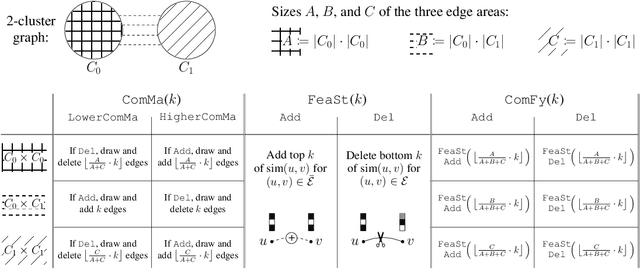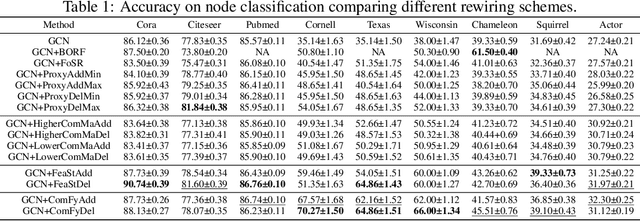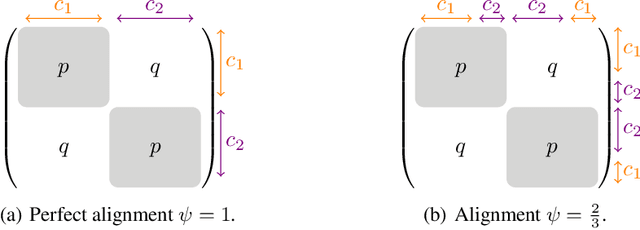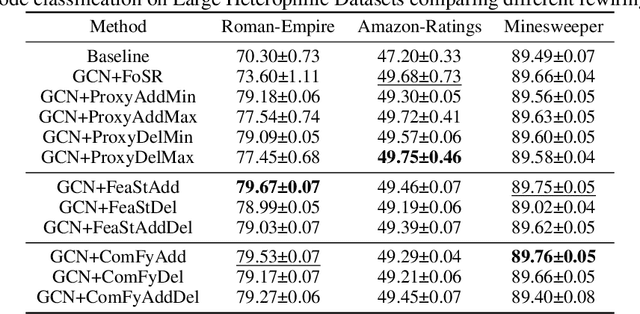Rebekka Burkholz
Pay Attention to Small Weights
Jun 26, 2025Abstract:Finetuning large pretrained neural networks is known to be resource-intensive, both in terms of memory and computational cost. To mitigate this, a common approach is to restrict training to a subset of the model parameters. By analyzing the relationship between gradients and weights during finetuning, we observe a notable pattern: large gradients are often associated with small-magnitude weights. This correlation is more pronounced in finetuning settings than in training from scratch. Motivated by this observation, we propose NANOADAM, which dynamically updates only the small-magnitude weights during finetuning and offers several practical advantages: first, this criterion is gradient-free -- the parameter subset can be determined without gradient computation; second, it preserves large-magnitude weights, which are likely to encode critical features learned during pretraining, thereby reducing the risk of catastrophic forgetting; thirdly, it permits the use of larger learning rates and consistently leads to better generalization performance in experiments. We demonstrate this for both NLP and vision tasks.
When Shift Happens - Confounding Is to Blame
May 27, 2025Abstract:Distribution shifts introduce uncertainty that undermines the robustness and generalization capabilities of machine learning models. While conventional wisdom suggests that learning causal-invariant representations enhances robustness to such shifts, recent empirical studies present a counterintuitive finding: (i) empirical risk minimization (ERM) can rival or even outperform state-of-the-art out-of-distribution (OOD) generalization methods, and (ii) its OOD generalization performance improves when all available covariates, not just causal ones, are utilized. Drawing on both empirical and theoretical evidence, we attribute this phenomenon to hidden confounding. Shifts in hidden confounding induce changes in data distributions that violate assumptions commonly made by existing OOD generalization approaches. Under such conditions, we prove that effective generalization requires learning environment-specific relationships, rather than relying solely on invariant ones. Furthermore, we show that models augmented with proxies for hidden confounders can mitigate the challenges posed by hidden confounding shifts. These findings offer new theoretical insights and practical guidance for designing robust OOD generalization algorithms and principled covariate selection strategies.
Sign-In to the Lottery: Reparameterizing Sparse Training From Scratch
Apr 17, 2025Abstract:The performance gap between training sparse neural networks from scratch (PaI) and dense-to-sparse training presents a major roadblock for efficient deep learning. According to the Lottery Ticket Hypothesis, PaI hinges on finding a problem specific parameter initialization. As we show, to this end, determining correct parameter signs is sufficient. Yet, they remain elusive to PaI. To address this issue, we propose Sign-In, which employs a dynamic reparameterization that provably induces sign flips. Such sign flips are complementary to the ones that dense-to-sparse training can accomplish, rendering Sign-In as an orthogonal method. While our experiments and theory suggest performance improvements of PaI, they also carve out the main open challenge to close the gap between PaI and dense-to-sparse training.
Mirror, Mirror of the Flow: How Does Regularization Shape Implicit Bias?
Apr 17, 2025



Abstract:Implicit bias plays an important role in explaining how overparameterized models generalize well. Explicit regularization like weight decay is often employed in addition to prevent overfitting. While both concepts have been studied separately, in practice, they often act in tandem. Understanding their interplay is key to controlling the shape and strength of implicit bias, as it can be modified by explicit regularization. To this end, we incorporate explicit regularization into the mirror flow framework and analyze its lasting effects on the geometry of the training dynamics, covering three distinct effects: positional bias, type of bias, and range shrinking. Our analytical approach encompasses a broad class of problems, including sparse coding, matrix sensing, single-layer attention, and LoRA, for which we demonstrate the utility of our insights. To exploit the lasting effect of regularization and highlight the potential benefit of dynamic weight decay schedules, we propose to switch off weight decay during training, which can improve generalization, as we demonstrate in experiments.
GNNs Getting ComFy: Community and Feature Similarity Guided Rewiring
Feb 07, 2025



Abstract:Maximizing the spectral gap through graph rewiring has been proposed to enhance the performance of message-passing graph neural networks (GNNs) by addressing over-squashing. However, as we show, minimizing the spectral gap can also improve generalization. To explain this, we analyze how rewiring can benefit GNNs within the context of stochastic block models. Since spectral gap optimization primarily influences community strength, it improves performance when the community structure aligns with node labels. Building on this insight, we propose three distinct rewiring strategies that explicitly target community structure, node labels, and their alignment: (a) community structure-based rewiring (ComMa), a more computationally efficient alternative to spectral gap optimization that achieves similar goals; (b) feature similarity-based rewiring (FeaSt), which focuses on maximizing global homophily; and (c) a hybrid approach (ComFy), which enhances local feature similarity while preserving community structure to optimize label-community alignment. Extensive experiments confirm the effectiveness of these strategies and support our theoretical insights.
Mask in the Mirror: Implicit Sparsification
Aug 19, 2024



Abstract:Sparsifying deep neural networks to reduce their inference cost is an NP-hard problem and difficult to optimize due to its mixed discrete and continuous nature. Yet, as we prove, continuous sparsification has already an implicit bias towards sparsity that would not require common projections of relaxed mask variables. While implicit rather than explicit regularization induces benefits, it usually does not provide enough flexibility in practice, as only a specific target sparsity is obtainable. To exploit its potential for continuous sparsification, we propose a way to control the strength of the implicit bias. Based on the mirror flow framework, we derive resulting convergence and optimality guarantees in the context of underdetermined linear regression and demonstrate the utility of our insights in more general neural network sparsification experiments, achieving significant performance gains, particularly in the high-sparsity regime. Our theoretical contribution might be of independent interest, as we highlight a way to enter the rich regime and show that implicit bias is controllable by a time-dependent Bregman potential.
Cyclic Sparse Training: Is it Enough?
Jun 07, 2024



Abstract:The success of iterative pruning methods in achieving state-of-the-art sparse networks has largely been attributed to improved mask identification and an implicit regularization induced by pruning. We challenge this hypothesis and instead posit that their repeated cyclic training schedules enable improved optimization. To verify this, we show that pruning at initialization is significantly boosted by repeated cyclic training, even outperforming standard iterative pruning methods. The dominant mechanism how this is achieved, as we conjecture, can be attributed to a better exploration of the loss landscape leading to a lower training loss. However, at high sparsity, repeated cyclic training alone is not enough for competitive performance. A strong coupling between learnt parameter initialization and mask seems to be required. Standard methods obtain this coupling via expensive pruning-training iterations, starting from a dense network. To achieve this with sparse training instead, we propose SCULPT-ing, i.e., repeated cyclic training of any sparse mask followed by a single pruning step to couple the parameters and the mask, which is able to match the performance of state-of-the-art iterative pruning methods in the high sparsity regime at reduced computational cost.
GATE: How to Keep Out Intrusive Neighbors
Jun 01, 2024



Abstract:Graph Attention Networks (GATs) are designed to provide flexible neighborhood aggregation that assigns weights to neighbors according to their importance. In practice, however, GATs are often unable to switch off task-irrelevant neighborhood aggregation, as we show experimentally and analytically. To address this challenge, we propose GATE, a GAT extension that holds three major advantages: i) It alleviates over-smoothing by addressing its root cause of unnecessary neighborhood aggregation. ii) Similarly to perceptrons, it benefits from higher depth as it can still utilize additional layers for (non-)linear feature transformations in case of (nearly) switched-off neighborhood aggregation. iii) By down-weighting connections to unrelated neighbors, it often outperforms GATs on real-world heterophilic datasets. To further validate our claims, we construct a synthetic test bed to analyze a model's ability to utilize the appropriate amount of neighborhood aggregation, which could be of independent interest.
CAVACHON: a hierarchical variational autoencoder to integrate multi-modal single-cell data
May 28, 2024



Abstract:Paired single-cell sequencing technologies enable the simultaneous measurement of complementary modalities of molecular data at single-cell resolution. Along with the advances in these technologies, many methods based on variational autoencoders have been developed to integrate these data. However, these methods do not explicitly incorporate prior biological relationships between the data modalities, which could significantly enhance modeling and interpretation. We propose a novel probabilistic learning framework that explicitly incorporates conditional independence relationships between multi-modal data as a directed acyclic graph using a generalized hierarchical variational autoencoder. We demonstrate the versatility of our framework across various applications pertinent to single-cell multi-omics data integration. These include the isolation of common and distinct information from different modalities, modality-specific differential analysis, and integrated cell clustering. We anticipate that the proposed framework can facilitate the construction of highly flexible graphical models that can capture the complexities of biological hypotheses and unravel the connections between different biological data types, such as different modalities of paired single-cell multi-omics data. The implementation of the proposed framework can be found in the repository https://github.com/kuijjerlab/CAVACHON.
Spectral Graph Pruning Against Over-Squashing and Over-Smoothing
Apr 06, 2024



Abstract:Message Passing Graph Neural Networks are known to suffer from two problems that are sometimes believed to be diametrically opposed: over-squashing and over-smoothing. The former results from topological bottlenecks that hamper the information flow from distant nodes and are mitigated by spectral gap maximization, primarily, by means of edge additions. However, such additions often promote over-smoothing that renders nodes of different classes less distinguishable. Inspired by the Braess phenomenon, we argue that deleting edges can address over-squashing and over-smoothing simultaneously. This insight explains how edge deletions can improve generalization, thus connecting spectral gap optimization to a seemingly disconnected objective of reducing computational resources by pruning graphs for lottery tickets. To this end, we propose a more effective spectral gap optimization framework to add or delete edges and demonstrate its effectiveness on large heterophilic datasets.
 Add to Chrome
Add to Chrome Add to Firefox
Add to Firefox Add to Edge
Add to Edge